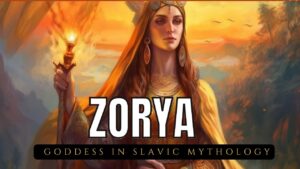It was said that the Auroras kept an eye on Simargl, the evil dog. This dog is attached to the very top of Polaris in the sign Ursa Minor, which means “the little bear.” Everyone thought that the world would end if he broke the chains, so they had to keep an eye on him. Zurya was born and raised on the island of Bouyan. People said that this spot was a mythical haven where the Sun lived and the winds from the North, East, and West met. But no one could ever go to space. Men wanted to be close to the Zorya because they were so pretty, but they couldn’t.
Zorya was also shown by the stars, both in the morning and at night. Again, a cult for the stars shows how much people care about ceremonies that use the strength of nature. It looks like the Slavic religion cared more about how people interacted with nature than other old religions. It was Zorja Utrennjaja who was the Morning Star. A lot of people believed that this star could lead to Dazbog. “Utro” in Russian means “morning,” which is where this book’s title comes from. But this star has a name in every Slavic language.
To keep people safe, the Morning Star was linked to horse riders, light, and getting rid of bad spirits. People believed it made them feel good and cleansed their souls. Zorya was also connected to Venus, and some of her traits were the same as those of Venus in Roman mythology and Aphrodite in Greek mythology. Serbs worshiped her every morning when the sun came up because she brought them new days, new chances, and new ways to reach their goals. Zoorya is said to be married to the god Perun in some stories. She was with her husband during fights. It was her job to make sure the fighters didn’t die. She covered them with her veil to do this. She also brought them light and hope when they lost a fight. She is married to the moon god Myesyats and the mother of a star in other stories. Sometimes, the Evening Star is also called Myesyats’ wife.
It was Zorya Vechernjaja, the evening star, job to lock the gates to Dazbog’s house. She had something to do with Mercury. The stories say that she was the one who helped travelers who got lost find their way. She was also married to Myesyats and the mother of two stars that helped people find their way. There may have been an afternoon star as well, but no one remembers her. There are no records that could help explain it. In the same way, some experts believe Zorya was a goddess who was a lot like Venus. Someone wrote about the bond between these goddesses in the past, but no one has found any records of it.
Today, most people don’t remember the Slavic gods. There is no doubt that their names made it into the Slavic languages. “Zorza” in Polish means “dawn.” Many old Slavic myths and beliefs are being told at modern pagan gatherings. The story of the goddess Zorya is just one small part of these stories. People today who try to make these gods come back to life are known as “modern pagans.” Zorya shows up in a lot of books, like the fiction series “The Iron Druid Chronicles” by Kevin Hearne. A piece called Zorya Vechernyaya was also written by an Australian named Julian Cochran for bassoon, woodwinds, and string quartet. A lot of years have passed, but people in these places are now making songs, telling stories, and dancing in old ways to make the old views stronger again.






